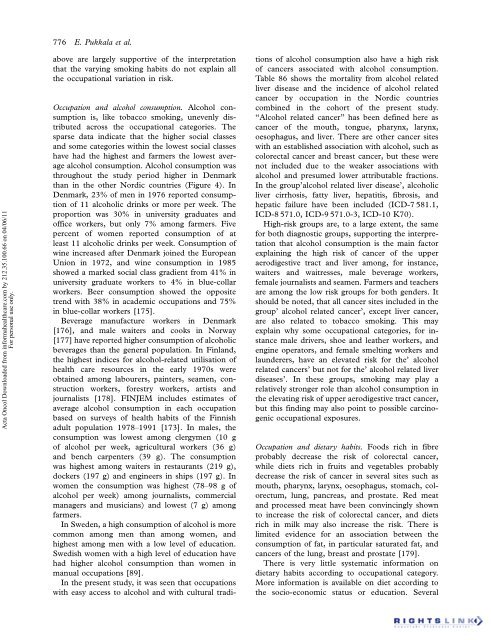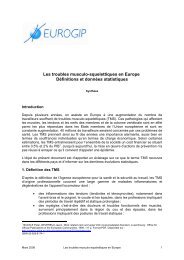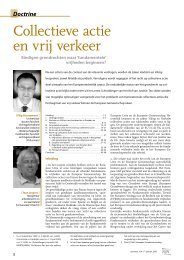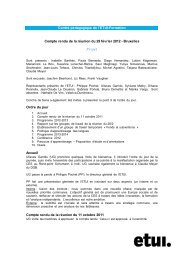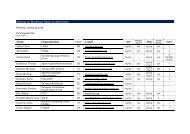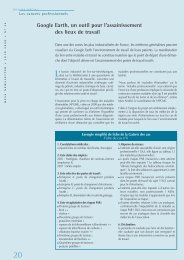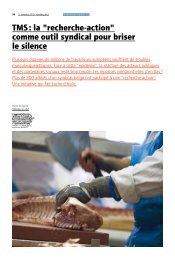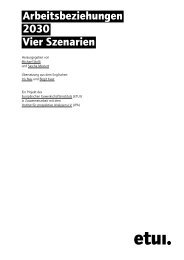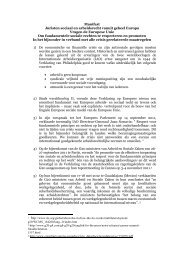Occupation and cancer - European Trade Union Institute (ETUI)
Occupation and cancer - European Trade Union Institute (ETUI)
Occupation and cancer - European Trade Union Institute (ETUI)
Create successful ePaper yourself
Turn your PDF publications into a flip-book with our unique Google optimized e-Paper software.
Acta Oncol Downloaded from informahealthcare.com by 212.35.100.66 on 04/06/11<br />
For personal use only.<br />
776 E. Pukkala et al.<br />
above are largely supportive of the interpretation<br />
that the varying smoking habits do not explain all<br />
the occupational variation in risk.<br />
<strong>Occupation</strong> <strong>and</strong> alcohol consumption. Alcohol consumption<br />
is, like tobacco smoking, unevenly distributed<br />
across the occupational categories. The<br />
sparse data indicate that the higher social classes<br />
<strong>and</strong> some categories within the lowest social classes<br />
have had the highest <strong>and</strong> farmers the lowest average<br />
alcohol consumption. Alcohol consumption was<br />
throughout the study period higher in Denmark<br />
than in the other Nordic countries (Figure 4). In<br />
Denmark, 23% of men in 1976 reported consumption<br />
of 11 alcoholic drinks or more per week. The<br />
proportion was 30% in university graduates <strong>and</strong><br />
office workers, but only 7% among farmers. Five<br />
percent of women reported consumption of at<br />
least 11 alcoholic drinks per week. Consumption of<br />
wine increased after Denmark joined the <strong>European</strong><br />
<strong>Union</strong> in 1972, <strong>and</strong> wine consumption in 1985<br />
showed a marked social class gradient from 41% in<br />
university graduate workers to 4% in blue-collar<br />
workers. Beer consumption showed the opposite<br />
trend with 38% in academic occupations <strong>and</strong> 75%<br />
in blue-collar workers [175].<br />
Beverage manufacture workers in Denmark<br />
[176], <strong>and</strong> male waiters <strong>and</strong> cooks in Norway<br />
[177] have reported higher consumption of alcoholic<br />
beverages than the general population. In Finl<strong>and</strong>,<br />
the highest indices for alcohol-related utilisation of<br />
health care resources in the early 1970s were<br />
obtained among labourers, painters, seamen, construction<br />
workers, forestry workers, artists <strong>and</strong><br />
journalists [178]. FINJEM includes estimates of<br />
average alcohol consumption in each occupation<br />
based on surveys of health habits of the Finnish<br />
adult population 1978 1991 [173]. In males, the<br />
consumption was lowest among clergymen (10 g<br />
of alcohol per week, agricultural workers (36 g)<br />
<strong>and</strong> bench carpenters (39 g). The consumption<br />
was highest among waiters in restaurants (219 g),<br />
dockers (197 g) <strong>and</strong> engineers in ships (197 g). In<br />
women the consumption was highest (78 98 g of<br />
alcohol per week) among journalists, commercial<br />
managers <strong>and</strong> musicians) <strong>and</strong> lowest (7 g) among<br />
farmers.<br />
In Sweden, a high consumption of alcohol is more<br />
common among men than among women, <strong>and</strong><br />
highest among men with a low level of education.<br />
Swedish women with a high level of education have<br />
had higher alcohol consumption than women in<br />
manual occupations [89].<br />
In the present study, it was seen that occupations<br />
with easy access to alcohol <strong>and</strong> with cultural tradi-<br />
tions of alcohol consumption also have a high risk<br />
of <strong>cancer</strong>s associated with alcohol consumption.<br />
Table 86 shows the mortality from alcohol related<br />
liver disease <strong>and</strong> the incidence of alcohol related<br />
<strong>cancer</strong> by occupation in the Nordic countries<br />
combined in the cohort of the present study.<br />
‘‘Alcohol related <strong>cancer</strong>’’ has been defined here as<br />
<strong>cancer</strong> of the mouth, tongue, pharynx, larynx,<br />
oesophagus, <strong>and</strong> liver. There are other <strong>cancer</strong> sites<br />
with an established association with alcohol, such as<br />
colorectal <strong>cancer</strong> <strong>and</strong> breast <strong>cancer</strong>, but these were<br />
not included due to the weaker associations with<br />
alcohol <strong>and</strong> presumed lower attributable fractions.<br />
In the group’alcohol related liver disease’, alcoholic<br />
liver cirrhosis, fatty liver, hepatitis, fibrosis, <strong>and</strong><br />
hepatic failure have been included (ICD-7 581.1,<br />
ICD-8 571.0, ICD-9 571.0-3, ICD-10 K70).<br />
High-risk groups are, to a large extent, the same<br />
for both diagnostic groups, supporting the interpretation<br />
that alcohol consumption is the main factor<br />
explaining the high risk of <strong>cancer</strong> of the upper<br />
aerodigestive tract <strong>and</strong> liver among, for instance,<br />
waiters <strong>and</strong> waitresses, male beverage workers,<br />
female journalists <strong>and</strong> seamen. Farmers <strong>and</strong> teachers<br />
are among the low risk groups for both genders. It<br />
should be noted, that all <strong>cancer</strong> sites included in the<br />
group’ alcohol related <strong>cancer</strong>’, except liver <strong>cancer</strong>,<br />
are also related to tobacco smoking. This may<br />
explain why some occupational categories, for instance<br />
male drivers, shoe <strong>and</strong> leather workers, <strong>and</strong><br />
engine operators, <strong>and</strong> female smelting workers <strong>and</strong><br />
launderers, have an elevated risk for the’ alcohol<br />
related <strong>cancer</strong>s’ but not for the’ alcohol related liver<br />
diseases’. In these groups, smoking may play a<br />
relatively stronger role than alcohol consumption in<br />
the elevating risk of upper aerodigestive tract <strong>cancer</strong>,<br />
but this finding may also point to possible carcinogenic<br />
occupational exposures.<br />
<strong>Occupation</strong> <strong>and</strong> dietary habits. Foods rich in fibre<br />
probably decrease the risk of colorectal <strong>cancer</strong>,<br />
while diets rich in fruits <strong>and</strong> vegetables probably<br />
decrease the risk of <strong>cancer</strong> in several sites such as<br />
mouth, pharynx, larynx, oesophagus, stomach, colorectum,<br />
lung, pancreas, <strong>and</strong> prostate. Red meat<br />
<strong>and</strong> processed meat have been convincingly shown<br />
to increase the risk of colorectal <strong>cancer</strong>, <strong>and</strong> diets<br />
rich in milk may also increase the risk. There is<br />
limited evidence for an association between the<br />
consumption of fat, in particular saturated fat, <strong>and</strong><br />
<strong>cancer</strong>s of the lung, breast <strong>and</strong> prostate [179].<br />
There is very little systematic information on<br />
dietary habits according to occupational category.<br />
More information is available on diet according to<br />
the socio-economic status or education. Several


